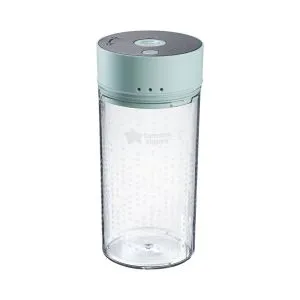
Tommee Tipps
Every weaning journey is different. Learn the signs that your baby may be ready to move onto solid foods, and some top tips to help things go smoothly.
How to Wean Off Breastfeeding & Bottle Feeds
If you're thinking of weaning your little one off milk feeds, you may have some questions. So, let's run through when to start weaning off breastfeeding and bottle feeds, how to know that your baby is ready to start eating solid or pureed foods, and cover some top weaning tips.
When should you start weaning off breastfeeding and bottles?
It's recommended that babies are exclusively breastfed for at least the first six months of their life. From this point, they can start eating solid foods.
But the truth is, parents can keep breastfeeding their little one beyond six months and can continue for as long as they want. It’s all about what works best for you and your baby.
Signs your baby is ready to start weaning
Some babies are ready to wean sooner or later than others, and you can look out for these tell-tale signs to know when your little one is ready to start eating purees or solid foods:
- They can sit upright without your support
- They can hold and grasp on to things
- They can bring food to their mouth and have good hand-eye coordination
- They show an interest in food and copy you when you eat
- They can swallow food instead of spitting it back up
It's good to be aware that some normal baby behaviours, such as wanting extra feeds or chewing their fists, aren't usually indicators that a baby is ready to start weaning.
How long does weaning take?
Put simply, weaning starts when little ones begin to eat food other milk, and finishes when they no longer have milk feeds.
Weaning is a very personal process that’s different for each parent and baby. It can be baby-led or parent-led, and can take days, weeks or months to move a baby on from breast milk. In fact, parents often continue to give milk feeds while they're weaning their baby onto solids.
If you're breastfeeding, you'll notice that as your breast milk feeds reduce in length and amount, your breast milk supply will also gradually decrease.
What are the three stages of weaning?
Let’s break down the stages of weaning and what's involved at each step:
Stage 1: First solid foods from six months
From six months, babies should be given a small amount of food before or after a milk feed. This should be at a time when they're likely to not be too hungry or tired. Types of food given to them at this stage can include soft sticks or florets of vegetables, soft fruits, and natural yoghurt. It’s a good idea to start with just one meal of purees or finger foods a day as they build up their skills and confidence.
You can also begin to give them foods that can potentially trigger allergic reactions, such as peanuts, at this early stage. Just make sure you introduce these one at a time (leaving a two to three-day gap between them) and in very small amounts. That way, you’ll be able to spot any reaction.
Stage 2: Exploring new flavours from seven to nine months
As you reach the second stage of your weaning journey, you should give your little one milk feeds responsively. During these months you can:
- introduce a wider range of tastes and textures by offering lumpier foods and herbs and spices (but avoid added salt and sugar in their meals)
- start to work towards offering three meals a day
- include iron rich-foods in their meals, like legumes, dark leafy green, and whole grains.
Stage 3: Feeding themselves from 10 months to one year
Between 10 and 12 months, you can continue to offer milk feeds responsively, while giving your baby three varied meals a day, including a range of family foods. By this age, they'll be able to chew food properly, and begin to develop a pincer grip that helps them pick up smaller pieces of food.
It’s important to note that babies shouldn’t drink cow's milk from a cup until the age of 12 months.
How to start weaning
There are several things you'll need to consider before you begin to wean your baby.
Get all the weaning equipment you need
Before you start, you should try to stock up on the following baby weaning essentials.
- A breast pump to express breast milk to help your boobs stay comfortable as you move away from breastfeeding.
- A supportive highchair (always make sure that your baby is alert and seated safely upright in their highchair while eating).
- Age-appropriate cutlery like our weaning spoons.
- Baby-safe tableware.
- Silicone bibs and long-sleeved bib suits to catch any mess.
- A blender or baby food maker to make baby food at home.
Find the right weaning approach for you
There are a couple of different approaches to weaning a baby. Some parents:
- opt for traditional weaning, which involves offering purees and mashed food until their little one's teeth appear
- go for the baby-led weaning approach – when the baby takes the lead and feeds themselves!
- use a combination of the two – spoon feeding and BLW (baby-led weaning).
The truth is, there's no right or wrong way to wean! The most important thing is that you choose a method that’s right for you and your baby.
Choose the right types of food
When you first start weaning, it’s a good idea to begin by offering your baby soft or pureed fruit and veg. You can then move on to chopped soft batons that are sturdy enough for them to hold but soft enough to be squashed. They should be around the shape and size of an adult finger so they can be easily gripped.
It’s important to always consider your little one's safety when choosing weaning foods to lower the risk of choking, so remember to:
- chop and prepare foods as needed to make them safe
- remove tough skins, seeds, pips and peels
- slice small, round food items – like strawberries, grapes, and cherry tomatoes – into quarters
- move through finger foods gradually to allow time for new skills to develop
Top weaning tips
Now that we've covered what weaning is and how you can start weaning your baby, let's finish with some of our top weaning tips.
- Make sure you still give your little one lots of cuddles to comfort them during the process of weaning off breast feeds.
- Ask your midwife or a Lactation Consultant for advice on how to wean away from breastfeeds.
- Learn how to spot the difference between choking and gagging when introducing solid foods.
- If one weaning method isn't working well for you, don’t be afraid to branch out and try something new like different finger foods or offering food on a spoon.
- Let your baby get messy. The truth is, mess is a BIG part of weaning and happens as a baby explores new textures and learns to use their hands and mouth in new ways.
- Eat your meals when you offer your baby their food to lead by example.
- Sit your baby at or close to the table in their highchair so they feel included during mealtimes.
- Continue to offer foods even if they don’t seem to like them, but stop when they shut their mouth, turn away or arch their back. Remember, it can take up to 10 tastes for a baby to decide if they dislike something or not, so be patient and don’t force it.
Sources









